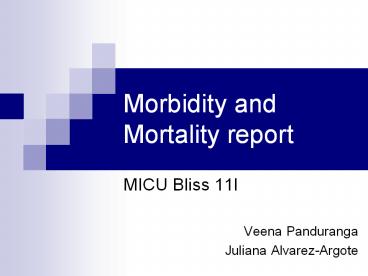Morbidity and Mortality report - PowerPoint PPT Presentation
Title:
Morbidity and Mortality report
Description:
Title: PowerPoint Presentation Author: juliana621 Last modified by: HH Created Date: 1/1/1601 12:00:00 AM Document presentation format: On-screen Show (4:3) – PowerPoint PPT presentation
Number of Views:428
Avg rating:3.0/5.0
Title: Morbidity and Mortality report
1
Morbidity and Mortality report
- MICU Bliss 11I
- Veena Panduranga
- Juliana Alvarez-Argote
2
Neuroleptic malignant syndrome
3
Learning Objectives
- Describe a case of neuroleptic malignant syndrome
- Review the pathophysiology, diagnosis, and
management of neuroleptic malignant syndrome
4
Overview
- Life-threatening, idiosyncratic reaction to
medications affecting central dopaminergic
neurotransmission. - Early recognition is critical to prevent
morbidity and death - First reported case in 1956 with chlorpromazine
Berman. Neurohospitalist. 2011 January
5
Overview
- Dopamine depletion
- Dopamine receptor blockers
- Virtually all antipsychotics, including atypical
antipsychotics - Cessation of dopaminergic medications
- levodopa, amantadine, tolcapone
- Incidence 0.02 to 2 of pts on neuroleptics
Adnet et al. Br J Anaest. 2000
6
Medications associated with NMS
Berman. Neurohospitalist. 2011 January
7
Pathophysiology
Strawn et al. Am J Psychiatry 1646, June 2007
8
Clinical presentation
- Within 2 weeks after exposure
- Most cases hours to days after exposure
- Muscular rigidity followed by hyperthermia in
several hours, along with wide range of altered
mental status - Drowsiness, agitation, confusion, delirium, coma
- Autonomic dysfunction labile BP, tachypnea,
tachycardia, sialorrhea, diaphoresis, flushing,
skin pallor, incontinence
Berman. Neurohospitalist. 2011 January
9
Lab findings
- High CK (rhabdomyolysis)
- Leukocytosis
- Iron deficiency (96)
- Renal failure (from rhabdomyolysis)
- Metabolic acidosis
- EEG non generalized slowing
Berman. Neurohospitalist. 2011 January
10
Diagnosis DSM IV criteria
- Two or more of
- Diaphoresis
- Dysphagia
- Tremor
- Incontinence (54)
- AMS
- Mutism (96)
- Tachycardia
- Labile BP (40)
- Leukocytosis
- Elevated CK (91)
- Muscular rigidity (96)
- Tgt100,4
- Use of neuroleptic medication
- Symptoms not explained by another substance or
medical condition
Perry and Wilborn. Ann Clin Psychiatry. 2012
11
Diagnosis
- DSM IV criteria
- Severe muscular rigidity and high temperature,
associated with use of neuroleptic medication - Two or more of diaphoresis, dysphagia, tremor,
incontinence, AMS, mutism, tachycardia, labile
BP, leukocytosis, elevated CK - Symptoms not explained by another substance or
medical condition
12
Differential diagnosis
- Heat stroke
- flaccid extremities, abrupt onset, hypotension,
dry skin - CNS infection
- Prodrome symptoms, meningismus, CSF labs
- Serotoninergic sd.
- Absence of high CK, leukocytosis, presence of GI
symptoms (n/v/d) - Lethal catatonia
- Psychosis for weeks prior to presentation
- Malignant hyperthermia
- History of depolarizing muscle relaxants or
inhaled anesthetics - Cocaine intoxication
- Alcohol w/d
Strawn et al. Am J Psychiatry. 2007
13
Management
- Neurologic emergency
- Many will need ICU level of care
- Stop neuroleptic
- Restart dopaminergic meds in withdrawal
(levodopa) - Aggressive hydration (if high CK, AKI)
- Control temperature
- Bicarb for AKI
- Cardio respiratory support
Adnet et al. Br J Anaest. 2000 Reulbach et al.
Critical Care 2007
14
Management
- Bromocriptine dopaminergic
- PO or NGT
- 2.5mg BID or TID
- increase up to 45mg/d
- Monitor liver function
- Benzodiazepines
- Reasonable first line
- 1-2mg IV/IM q 4-6h
- Mild/moderate cases or primarily catatonic
symptoms
Strawn et al. Am J Psychiatry. 2007 Reulbach et
al. Critical Care. 2007
15
Management
- Amantadine anticholinergic
- 100mg PO/NGT q 8h
- Moderate cases
- Dantrolene muscle relaxant, inhibits calcium
release from sarcoplasmic reticulum - Severe cases (T gt104, HR gt120)
- 2.5mg/Kg 1mg/Kg q 6h IV
- Increase up to 10mg/Kg/d
- Stop once symptoms resolving (resp
failure/hepatotoxicity) - ECT
- Cases with no response to medications/supportive
care
Strawn et al. Am J Psychiatry. 2007 Reulbach et
al. Critical Care. 2007
16
Complications
- Renal failure
- DIC
- Rhabdomyolysis
- MI
- Asp. PNA
- Seizures, arrhythmias (lyte abnormalities)
Reulbach et al. Critical Care 2007
17
When to restart neuroleptics
- Wait 2 weeks for PO antipsychotics
- Wait 5 weeks for depot forms
- Change neuroleptic med
- Switch from typical to atypical
- Start at low doses, titrate slowly
Neuroleptic Malignant Syndrome Information
Service. 2011. http//www.nmsis.org
18
Prognosis
- Mortality 40 before 1984
- Mortality greatly reduced (10) when recognized
and treated early - Recurrence of NMS in 30-50 cases after
restarting neuroleptics - Complete recovery in first 2 days to 2 weeks
- Mortality 2/2 arrhythmia, DIC, renal or CV
complications
Bottoni. Hospital physician. 2002
19
Take home points
- NMS is a rare but severe reaction to dopamine
blocking agents or withdrawal to dopaminergic
agents - Early recognition is critical in preventing
significant morbidity and mortality - Main manifestations are muscular rigidity,
hyperthermia and history of medication intake or
abrupt cessation - Main management consists of stopping offending
agent/restarting dopaminergic, aggressive
hydration and temperature control - Medications for NMS treatment include benzos,
dantrolene, - Many will require ICU level 2/2 cardiorespiratory
decompensation
20
Thank you!

